It’s June 5. I finish lunch in the Hilleberg and turn off the stove. The silence is refreshing. The non-stop blur of noise of the MSR WhisperLite stove becomes deafening after melting so much snow. There is only a moderate breeze streaming out of the north across the plateau at 17,000 feet – a pleasant reprieve from the previous weeks’ howling winds. It’s somewhere around -10°F. My teammates are making the most out of the downtime; napping or working through some Sudoku-esque puzzle that gives me a headache just watching. The unmistakable squeaky sound of crampons approaching in the snow rouses me from the stupor of my hot chocolate coma and gets me out into the thin air to see who is visiting. It’s snowing (sideways) and visibility is poor.
"Hello! We tell ranger solo climber at pass!” The two French climbers go on to describe in broken English the unfortunate situation of a solo Japanese climber they left at the pass an hour ago. The climber was out overnight without any camping gear, is reported to be hallucinating, vomiting and extremely exhausted. I thank the reporting party and go back inside the tent.
 A busy morning above High Camp on the Autobahn. NPS Photo courtesy of VIP Ryan Baker
A busy morning above High Camp on the Autobahn. NPS Photo courtesy of VIP Ryan Baker
My patrol members overheard parts of the conversation and are already discussing options. We work through the information we have -- discussing options, contingency plans, resource allocation, medical concerns, communication strategies, the weather, risk management -- and eventually cycle back to our options. This is not a complex scenario - there is a distressed climber at Denali Pass, 1,200 feet above us, on a traversing slope of moderate steepness called the Autobahn with existing pickets in place protecting the entire slope. We make a plan, pack our gear and wait. Once we’re packed, there’s no rush. The current weather is a no-go. Even a moderate wind at high camp with precipitation and poor visibility exceeds our risk threshold.
My primary concern is the safety of my team and my main objective is to come back with all fingers and toes. Every climber on Denali knows what my – and every other Ranger’s - priorities are when it comes to rescue. We dedicate an entire slide in our climber briefing presentation emphasizing the discretionary nature of rescue and the challenges that our patrol teams face with accessing patients in poor weather. There’s probably a part of every rescuer that chomps at the bit to charge out and get to the patient as soon as possible regardless of conditions, but we know better. The lessons learned from previous Denali Rangers, so many mountain professionals, and our own experience have taught us the importance of slowing down, managing the risks and planning for success. So that’s what we do. Two hours later, I’m well fed, hydrated and the weather has improved drastically so we head up the hill. I’m on a “hasty” team with another ranger and a volunteer. Our goal is to access the patient as quickly and safely as possible, assess, treat and come up with an evacuation plan. The remainder of our team, two very strong volunteers, start up a little while after us laden with a medical ‘jump’ kit, SKED, a 600-foot rope, and of course their own personal kits. Best case is a self-ambulatory patient in calm winds with the sun shining; worst case is an unresponsive patient in poor weather. There is never any way to prepare for all possible contingency plans so we plan for moving a non-ambulatory patient in technical terrain. The gear we bring supports this plan.
“Matt, Travis, radio check on local, how copy?”
“Copy, I have you Lima Charlie” he confirms.
I laugh out loud. And I know Matt’s laughing too. In his line of work, Matt has probably spent more time on the radio in stressful situations than our whole team combined and his experience shows. When Matt isn’t running a set-net operation for salmon off the Kenai Peninsula, he’s a Pararescueman (PJ) out of Anchorage and an important member of the team. He’s a strong climber, has an incredibly relaxed and easygoing demeanor, and he’s our medic. Every Ranger patrol recruits a highly trained medical team member who operates under a more advanced set of protocols than the rest of us, all EMT’s. I’m psyched he’s here. The radio lingo on the mountain has become an ongoing source of humor amongst our team – it’s like a scene out of Rambo 4. Or was it 5? Best practice is to use plain English. Loud and Clear. Phonetics are so 1985. And 10 codes? Don’t get me started. Fortunately the enemy is not listening in to decipher our Denali radio conversations and plain English is perfectly adequate and preferred. And this from a big First Blood fan…
 Rescue training. NPS Photo courtesy of VIP Josh Stratman
Rescue training. NPS Photo courtesy of VIP Josh Stratman
We move up through the terrain, clipping pickets as we go. Matt and Josh are still in camp and now have eyes on a solo climber through a spotting scope that we keep in the High Camp cache. This is potentially our patient. He is moving slowly, with some stumbling, down the Autobahn taking frequent breaks and sitting down. We get updates on the radio from Matt as we continue to move upward to intercept the climber. “…copy, Lima Charlie.”
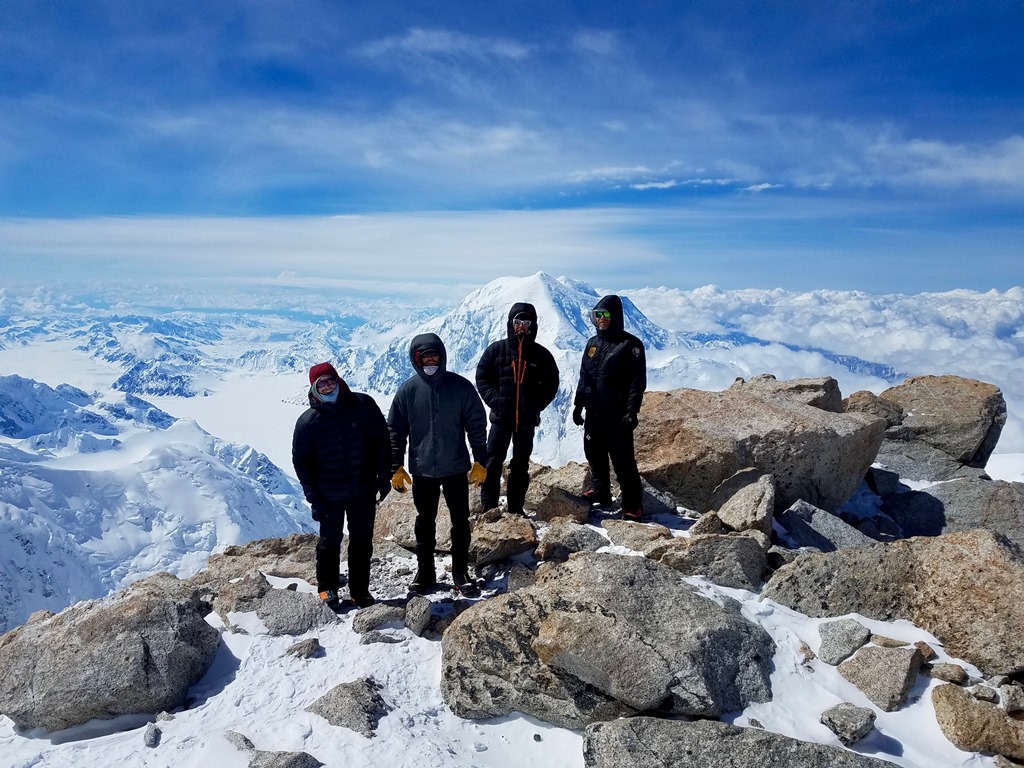 Josh snapped this photo of our crew at High Camp. NPS Photo courtesy of VIP Josh Stratman
Josh snapped this photo of our crew at High Camp. NPS Photo courtesy of VIP Josh Stratman
Chris, the other ranger on our team and leader of our crew, is out front on the rope team, taking his time through the terrain. He’s stopping regularly to dig out buried pickets and reposition them above the trail to allow for easier rope management on the descent with a patient. We move slowly upward but his work will pay dividends in efficiency on the way down and will expedite our progress. Chris is a long time ranger with a ton of experience on the mountain. This month-long patrol is actually part of a mentorship process for me, a second year ranger here on Denali, and Chris continues to set the bar high. Our team is extremely strong, and I wish I could take credit for assembling this group but I can’t. Chris recruited the 3 volunteers 6 months ago who have now travelled to Denali to volunteer their time for a month to keep this mountain safe and clean. Josh and Ryan round out our team for a total of 5. Ryan is rock solid. A Yosemite rock climber and wildland fire fighter, Ryan came up with little glacier experience but proved himself early as a competent mountaineer. He’s strong, is dialed with ropes and is jazzed to be up here. He’s heading back to Yosemite after this to work on the SAR team. Lucky team. He’s behind me on the rope team and I’m glad he’s there to anchor us down.
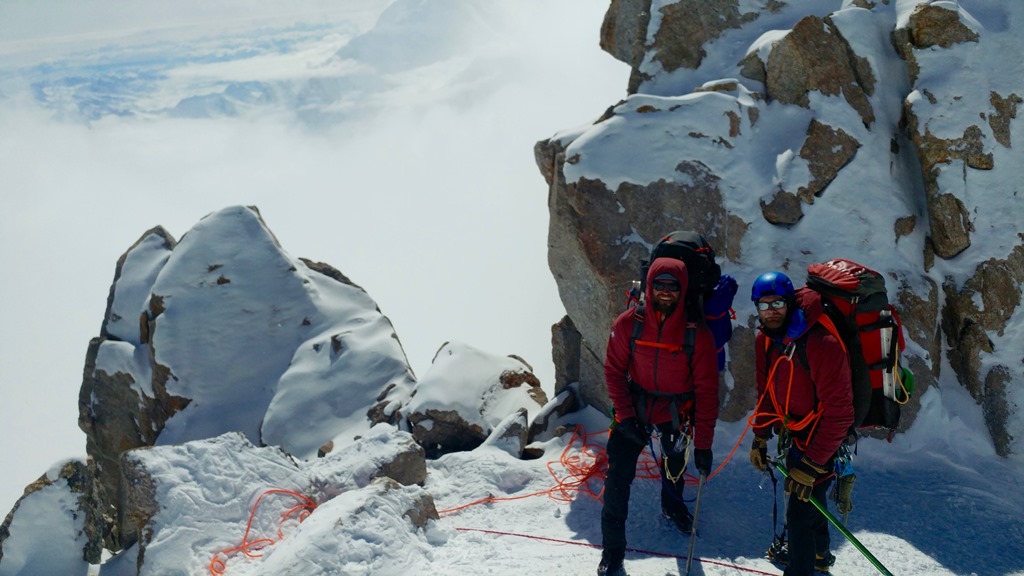 VIPs Josh and Matt on the ridge below High Camp. NPS Photo / Travis Baldwin
VIPs Josh and Matt on the ridge below High Camp. NPS Photo / Travis Baldwin
As we approach the patient, I’m running through differentials and treatments based on what I suspect. The reporting party said the climber was vomiting and disoriented which makes me think cerebral edema – our medical protocols call for specific drugs for HACE so I run through those in my mind and where they are in my pack. I also consider dehydration, hypoglycemia, orthopaedic trauma and a few other diagnoses and what those treatments would entail. Ultimately, our goal is to get this guy down the hill to a tent and out of the elements to perform a more thorough assessment.
At about 5:00 pm, we reach the patient who has slowly made his way down the first quarter of the Autobahn. His English is poor which always makes assessment more challenging but he seems to be alert and oriented but clearly exhausted. I continue to run through my checks. He doesn’t report any pain except for a headache. Good. Sounds like he hasn’t had anything to eat or drink in about 12 hours. Yikes. He is wearing a thin glove on one hand and an expedition mitten on the other. He tells me he lost his other mitten somewhere “up there.” I look at his hands – deep frostbite on several fingers of the gloved hand but no frostbite on the mitten hand. He tells me his feet are cold but this isn’t the place to take off his ski boots to visualize his feet so I ask about circulation and sensation in his feet. None of what I’m saying gets through and I’m not sure if he can feel his toes but I get the feeling he can’t. Time to move.
We’ve talked through this exact scenario and had already decided that if the patient can walk, even poorly, the plan will be to short-rope the patient down with a belay if necessary. The planning is part of our process. This team has lived, trained and worked together for the last 3 weeks on this mountain and the team dynamic is outstanding. We communicate well and everyone has quality input. This plan was generated hours ago and currently being executed. If something has to change it’s no big deal and we’ll work through each problem as it comes. Most of the problems were anticipated with backup plans already in place. The advantage of working with a solid team is obvious; we share a common goal and everyone contributes accordingly.
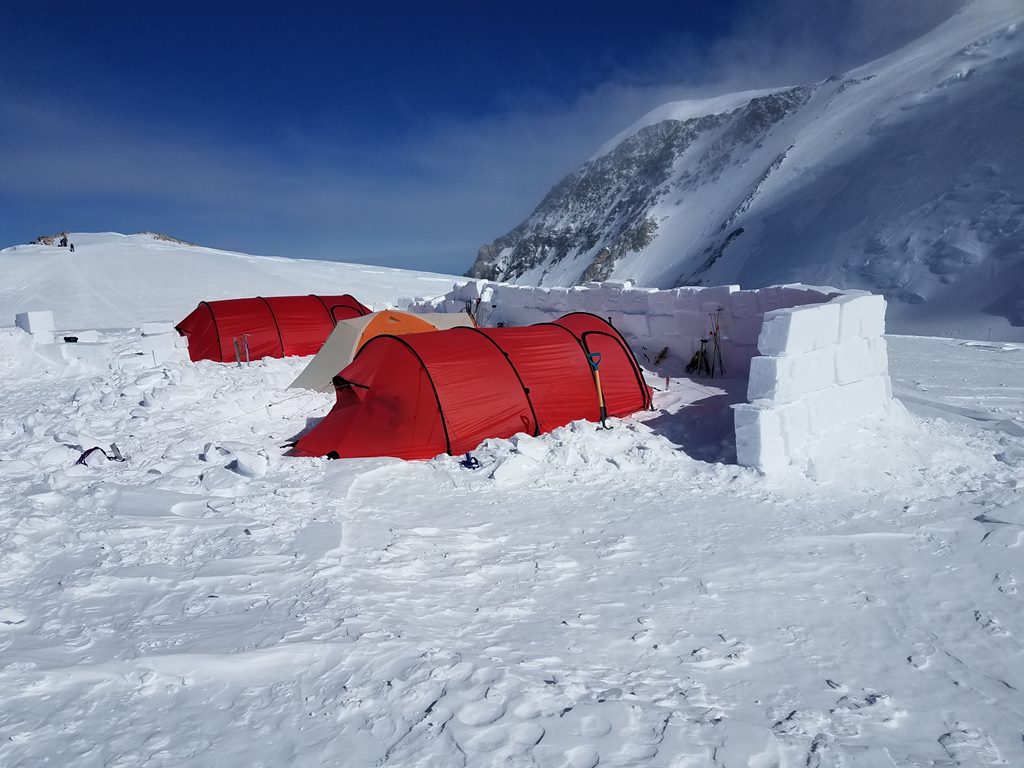 Our high camp at 17,200 feet. NPS Photo by Josh Stratman
Our high camp at 17,200 feet. NPS Photo by Josh Stratman
As we near the bottom of the Autobahn, the route turns downhill and becomes steeper. From a short-roping perspective, steeper terrain translates into higher risk. We could keep going, status quo, and save time by not increasing our safety margin. Sure, chances are everything would be fine but we have the tools to deal. At base camp we practiced constructing anchors and crevasse rescue. At Camp 3 (11,200 feet) we practiced lowering systems for technical terrain. I radio down to Josh who is about 100 meters ahead with Matt, stomping out steps in the snow, that this would be a great place for a belay – added security. I watch as Josh sets up a multiple picket anchor and gets it equalized while Matt sets up the descent control. Josh is an outdoor educator out of Portland. He hasn’t been on Denali, but he’s clearly spent some time in glacial terrain and setting up an equalized anchor doesn’t phase him and I barely have to wait. I’ve seen him place anchors before and I know that he pays attention to the details. I constantly get the feeling that Josh is always watching out for us. He’s observant, asks great questions and is always helping out – with everything. He’s in it for the team.
We clip the patient to the belay and make our way down to the flats at high camp uneventfully, just like it should be. We get the climber to his tent, do a full assessment and get him fed and hydrated. Aside from his hand, the climber has nine deep frostbitten toes. Hemorrhagic blebs will form in the coming days and chances are good he’ll lose multiple digits. I’m not an orthopedic surgeon -- but it turns out that my wife is -- and we’ve talked a lot about frostbite and looked at a lot of pictures and outcomes. The unfortunate part of the whole process is waiting weeks or even months for the dead tissue to demarcate so she knows where to amputate. That’s a lot of time to stare at your injuries and contemplate your decisions. Throughout this whole ordeal, the climber kept asking me in poor English if they will “cut off.” He was so concerned almost to the point of being distraught. I can only wonder what his decision making process was over the previous 24 hours to make him choose lost toes and almost death over a warm night in a sleeping bag to try for the summit on a better day. Maybe it’s not that simple. Maybe it is.
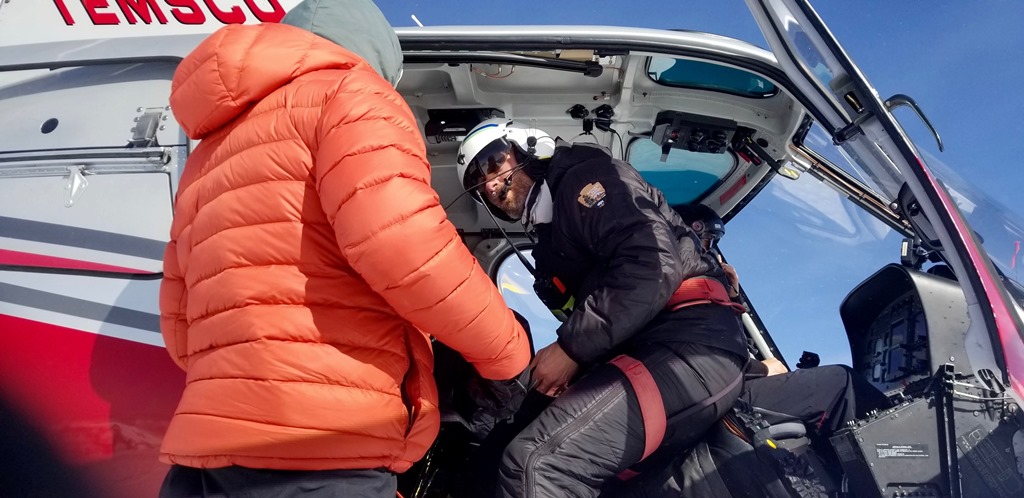 Chris loads the patient on the helicopter before flying back to Talkeetna. NPS Photo courtesy of VIP Ryan Baker
Chris loads the patient on the helicopter before flying back to Talkeetna. NPS Photo courtesy of VIP Ryan Baker
Unfortunately, there were several similar bad decisions in a very short period of time while we were on patrol. A solo Korean climber made a similar decision to push on to the summit overnight and had to be helped down the Autobahn as well and then continue to be helped from Washburn’s Thumb down through the fixed lines to Camp 4.
A pair of Americans made the same choice and also acquired frostbite a couple days prior. They had to be helped by a passing guide and assisted to their tent before descending. The climbers sure were proud to tell me they made the summit though. To top it off, one of the climbers then lost a boot near Washburn’s Thumb on the descent because the loss of sensation in his foot from frostbite prevented him from feeling that his boot had become untied and eventually loose enough to fall off his foot and tumble down to the Peters Glacier. I’m not making this up.
A trio of Japanese climbers made it to High Camp one evening before realizing they didn’t have any tent poles. Instead of going down to Camp 4 to retrieve poles they all piled into the tent (sans poles) and spent several nights in high wind huddling in the frameless nylon shell. They eventually made a summit attempt, were out for 18 hours and one of their team members got deep frostbite on two fingers.
The worst case, in my opinion, was a guided team whose lead guide chose to go up in very poor weather, continued up after all other teams (guided and private) had turned around, were out for about 20 hours and at least one of the clients got frostbite. The clients of guided groups pay a lot of money and put a tremendous amount of trust in their guides to make good decisions. While it is by no means always the fault of the guide if a client gets frostbite, to keep a group out in high winds and -20°F weather for 20 hours and return to high camp at 0430 is arguably a bad decision. One might even argue that frostbite is a foreseeable outcome of this decision…maybe. Thankfully this is not the norm, and most of the Denali guides that I know and have worked with are tremendous, hard working, and very experienced folks whose skill and experience is often taken for granted by the less trained eyes of their guests. I would recommend them in a heartbeat.
Finally, a group of three Americans made an attempt for the summit from camp at 14,200 feet up the Upper West Rib. One started experiencing altitude illness, but instead of all turning around to help the sick climber, the other two flipped a coin for who would have to go down and who could go up alone. So much for solid teamwork. The “lucky” climber who didn’t have to help his teammate down continued up, got stuck in bad weather, had a full epic on his way back down to camp and ended up with seven frostbitten fingers and a helicopter ride off the mountain. He chose poorly.
Enough ranting. As many or more lessons can be learned from all the good decisions that were made during our month on the mountain as bad decisions. But it’s easy to focus on the poor decisions with poor outcomes and pass over the hundreds of people who made the right decision, and had fantastic experiences on the mountain without frostbite or altitude illness. We so often seem to focus and analyze what went wrong instead of all the things that went right and I’m no different. Maybe it’s because I see a little of myself in these injured climbers who didn’t always get it right and made one bad decision that forced them toward a cascade of unfortunate circumstances. Did I just get lucky last time I made a bad decision in the mountains and not have to learn any hard lessons? I can’t say I don’t think about it. After all, do we not often go to the mountains to push our limits and seek out what lessons can be learned to further prepare us for success? I think so, but it’s a not-so-fine line between walking away with a healthy amount of respect and, well, not walking away.
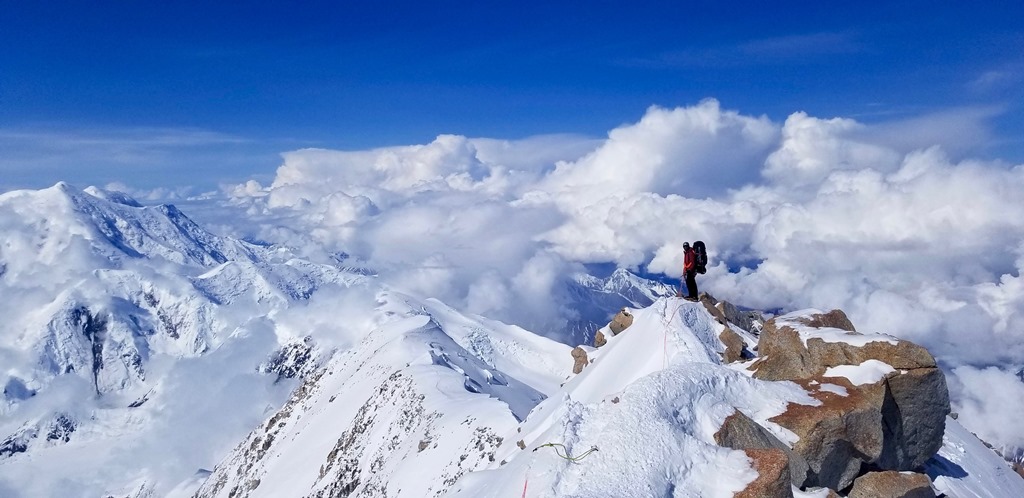 Matt, high on the 16K ridge, on a stunning June morning. NPS Photo courtesy of Ryan Baker
Matt, high on the 16K ridge, on a stunning June morning. NPS Photo courtesy of Ryan Baker
We cook up some freeze-dried Mountain House and debrief the operation. We’re all pleased with how things went. We followed the plan, adjusted our techniques to the terrain, maintained a healthy safety margin and accomplished the goal. If the weather is good in the morning we’ll fly the patient back to Talkeetna. It’s not feasible for this guy to self-evacuate at this point so he meets our criteria for helicopter evacuation. Turns out the weather was good the next morning and the patient flew off with Chris attending. It was a beautiful day and our team was able to get to the summit on the second to last day of our patrol. We did it without any frostbite and there were many decisions that led us to that specific outcome. It started with Chris recruiting a great team. Somewhere in the middle we set ourselves up for success with a combination of training, planning, teamwork and combined experience. In the end we made a decision to only go if the weather was good and turning around is always an option. Sure, you could argue that I work here, have more time to wait for good weather and don’t face the same pressures to summit as the other climbers here and I can’t argue that. But that has nothing to do with your decision to go or not go based on the information you have, the strength of your team or your risk management. At the end of the day, it’s your call and that’s the beauty of the mountains.
We get back from the summit and pile into the tent. I’m beat, it’s been a long month, but the energy in the tent is high. We all know that burgers and beer are only a couple days away. I radio down to Camp 4 that we’re back and all good. Dave is down at 14. He’s got an incredible crew as well and it’s comforting to know he’s backing us up down there. In the 2 seasons I’ve been here at Denali I’ve been impressed with the strength of the team and the resulting successes the rangers have had. It doesn’t happen by accident. It’s a result of leadership, consistent good decision-making and team buy-in. There is synergy at play here and it bounces back and forth across the rugged 60 mile stretch from Talkeetna to Denali.
“14 Camp this is High Camp on local, we’re back at camp for the night, all good.”
“Copy, back at camp, got you Lima Charlie. 14 Camp standing by.” Everyone chuckles. Dave gets it too.
